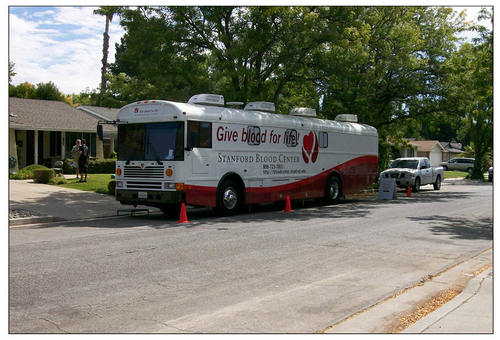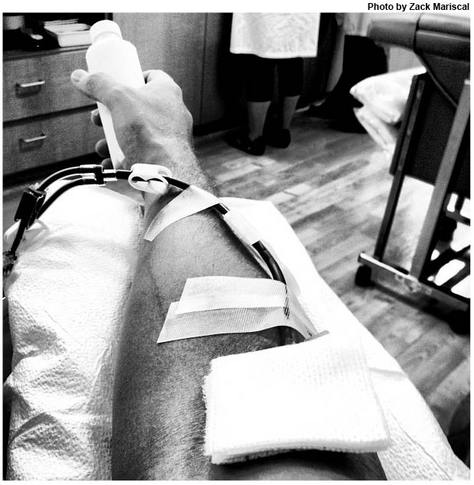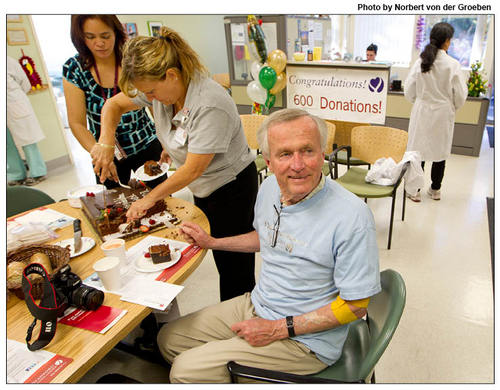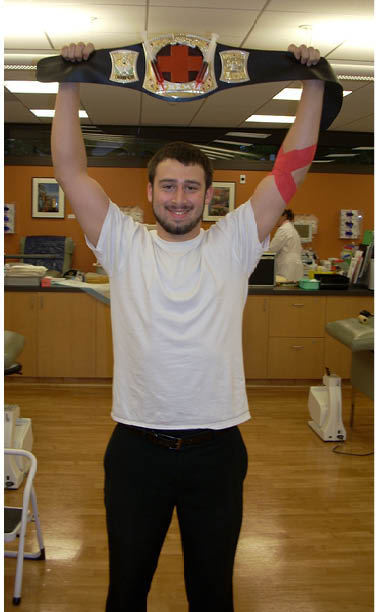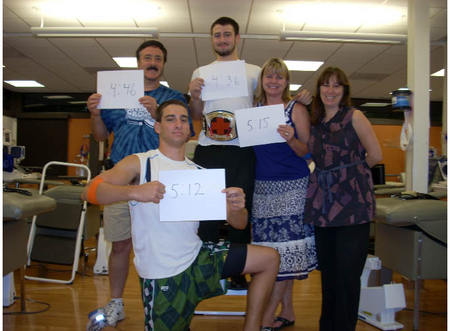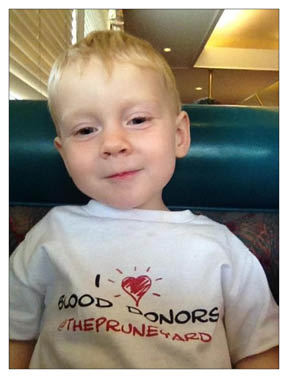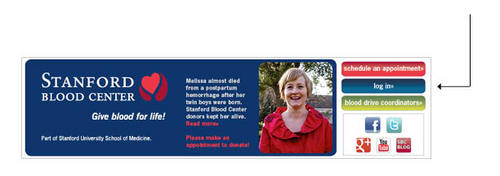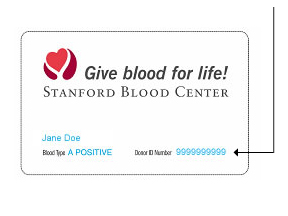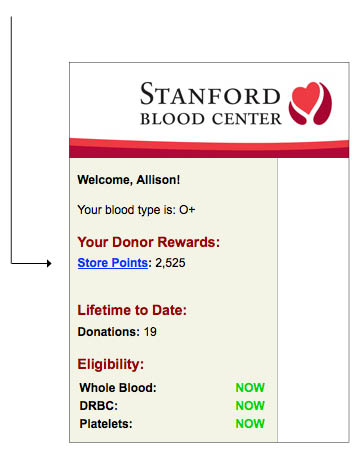August 2012
Beautiful Day in the Neighborhood
| Tweet |
By Deanna Bolio, Public Relations Associate, Stanford Blood Center
Stanford Blood Center Bloodmobiles travel thousands of miles each year to collect donations at mobile blood drives. They stop at businesses and schools, churches and hospitals. But you might be surprised to know that on rare occasions you can even catch these buses on quiet residential streets, parked next to yard sale signs and driveway basketball hoops. These community blood drives, often associated with a particular patient or blood recipient, offer a unique opportunity for a community to come together for a good cause.
“Working on community drives is truly one of the most rewarding aspects of my job,” said Tim Gilmore, Stanford Blood Center Account Manager. “I really enjoy working with the families and patients who benefit from blood donations.”
One of the first neighborhood blood drives began in 2009. Bob and Cristal Hernandez wanted to come up with a way to honor their daughter Ava, who passed away at four years old due to neuroblastoma, a highly aggressive form of cancer that typically affects infants and children. Cristal reached out to Stanford Blood Center and the inaugural “Ava’s Blood Drive” took place in their quiet San Jose neighborhood shortly after. Nearly 400 units have been collected in association with Ava’s Blood Drive, now in its fourth year.
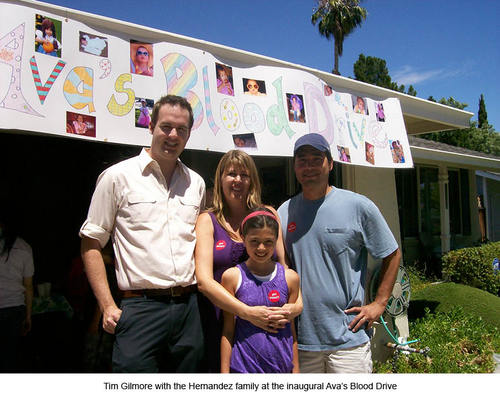
The following year, Dianna and Tim Murphy began hosting the “Pay it Forward” blood drive at their home in San Ramon as a way to honor their son Kevin’s second chance at life. At 12, Kevin’s health declined rapidly over the course of a month, which doctors determined was the result of cardiomyopathy, a weakening of the heart muscle. Kevin would need a life-saving heart transplant, which he received in February 2009. He is now a healthy teenager.
The first “Pay it Forward” blood drive was held one day prior to the first anniversary of Kevin’s surgery. The response to the blood drive was so great, the family decided to make it an annual event.
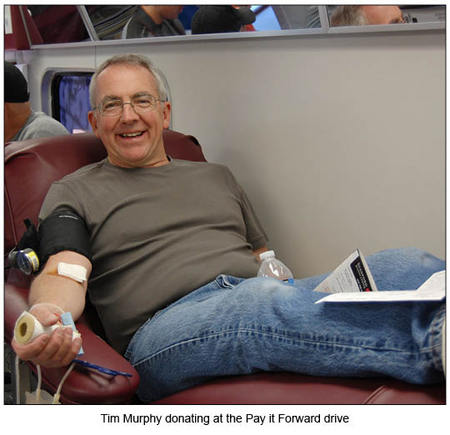
“Our community is so amazing and so supportive,” Dianna said. “I had a feeling that the blood drive would be successful, but I had no idea of the magnitude. The next year we had two buses.”
Donors at neighborhood blood drives include not only friends and family, but also coworkers, neighbors and even passersby. One married couple donating at a “Pay it Forward” drive were not familiar with the Murphy family, but were moved to donate by their own personal experiences with blood recipients.
“Seeing a community pull together to support a great cause is always a very humbling experience,” Gilmore said.
Whole Blood or Double Red Blood Cell Donation?
| Tweet |
By Julie Ruel, Social Media Manager, Stanford Blood Center
At Stanford Blood Center, we collect a combination of blood products (red blood cells, platelets, plasma) using different procedures and equipment. For the scope of this article, we’ll focus on two types of red blood cell donations: single unit and double unit.
Single-unit, or what we refer to as whole blood donations, are the most common type of donation at SBC and can be made up to six times per year. Each whole blood donation, after it has been processed in the lab, results in a unit each of red blood cells, frozen plasma, and white blood cell concentrates (cryoprecipitate). Separating the products allows us to provide hospitals with what patients need more specifically.
During a double red blood cell (DRBC) donation, we specifically collect the blood’s red cell component through an automated machine, called the Alyx. The target volume, once attained through collection, is divided into two processed units of red blood cells. Because of the additional red cell loss, this procedure can only be done three times per year.
So, from a blood center’s perspective, which donation type is preferred? Here at SBC, it depends on several factors:
• The immediate need of our inventory
• The donor’s blood type
• The donor's preferred donation frequency
• The donor's interest in an automated donation
Let’s explain in more detail. On the day of your visit, our collections staff may ask you to consider a certain donation type depending on the first bullet above: our inventory. What type of blood do we need that day to meet the needs of patients at the hospitals we serve? Would drawing a double unit be more effective in meeting the immediate demand? Another consideration is blood type. Types O, A, and B are more common among the general population and, therefore, these types are used more often for transfusions. Processing two units from one procedure, especially from O-negative donors (the universal blood type), is an efficient way to keep our inventory at a healthy level.
There are a couple other factors to look at when selecting the best donation type for each individual donor. What is the donor’s preferred frequency of visits? For those who visit a maximum of one or two times per year, a DRBC procedure will allow us to collect the same number of units annually as donating twice as often.
For those interested in an automated DRBC donation, there are some things to consider. DRBC donations do take about 30 minutes longer and have more specific eligibility requirements. However, many donors report feeling better after an automated donation because of the fluid replacement. Read more on our FAQ page (scroll toward the bottom).
Questions about our different donation types? Call our resource nurse at 650-725-9968 or send an email to sbconlinehelp@lists.stanford.edu.
The First to 600
| Tweet |
By Dayna Myers, Marketing Communications Manager, Stanford Blood Center
After more than two decades’ worth of visits, blood donor David “Mitch” Mitchell hit a unique milestone on August 20 when he became the first person to make 600 donations at Stanford Blood Center.
Mitchell, 75, regularly donates through a specialized two-hour process that allows the center to collect specific blood components, such as platelets. This donation type allows him to donate as many as 24 times a year.
Mitchell first began donating blood at age 17 when he was in the Air Force, and it quickly became a habit. “It only takes a couple of hours, and once you build it into your life, it just happens,” said the Mountain View resident. As a retired pilot, he travels often but makes sure to stay clear of malaria-risk areas, which would defer him from giving blood for one year.
He recalled attending a survivors’ dinner about 10 years ago where one blood recipient got up and thanked the blood donors in attendance by saying, “I’m here, you’re here and that’s good.” That’s his bottom line, Mitchell said. Donating is a small inconvenience, but it means the world to someone in need.
“Someone with a loved one who needs blood would offer every vein in their body,” he said. “Well, there are a lot of people out there who need blood and don’t have anyone to help, so I do what I can.”
Cancer and leukemia patients often depend upon platelet transfusions. For example, a leukemia patient might have a dangerously low platelet count that could be caused by the disease itself or by its treatment, which can damage bone marrow and result in hemorrhage. Platelet transfusions can help keep these patients alive while allowing enough time for their therapy to work.
Although Mitchell started as a whole-blood donor, Stanford quickly identified him as an ideal platelet donor. He has been donating regularly at the blood center ever since. “The nurses and medical assistants here are just a delight,” he said.
With donors Eric Buhr, Linda Johnson and Dick Tagg (see below), Mitchell is among an elite group who have given blood more than 500 times to the Stanford Blood Center.
* * * * * * * * * * * * * * * * * * * * * * * * * * * * * * * * * * * * * *
Gold-Blooded Family
| Tweet |
By Julie Ruel, Social Media Manager, Stanford Blood Center
When Randy Helmonds, wife Lisa, and their two teenage boys donate blood, they take an unconventional approach. Why sit quietly in the donor chair when it can be so much more exciting? “Creating a friendly, competitive environment is a fun direction to go,” shares Randy who wants blood donation to be something his family looks forward to.
The close-knit family of competitive sports players and routine blood donors enjoy bringing humor into their activities. When they visited SBC last week for their regular appointment, they decided to compete for gold in a new Olympic sport of their own invention. Who could fill the pint-size bag with blood in the least amount of time?
To prepare, older brother Douglas ran around the building several times to get his blood pumping faster. Turns out he’ll need a new coach next time. Just barely avoiding disqualification, he spent several minutes on the sidelines with an elevated pulse. Younger brother Thomas wore compression shorts in an effort to enhance his athletic performance. And the rest of the family relied on good ol’ luck. Rookie move.
As the needles went in, Lisa, the official timekeeper, started the clock. The seconds and minutes ticked by as the players faced their opponents across the room. At minute four, things got intense as Randy and Douglas’s bags neared the finish line. And about a half minute later, we had a champion! Douglas took the gold, leaving dad in second place.
The Helmonds plan to recruit more family members each time they visit and, says Randy, “The competition will continue”. For their next visit, we’re told they have something planned involving referee uniforms, flags, and boxing gloves, staying within the boundaries of the sport of blood donation, of course. (Hint: they’ll be eligible in just under eight weeks, typically donate at our Mountain View Center, and wouldn’t mind some fellow blood donors as spectators!).
Clockwise from bottom: Thomas, Randy, Douglas, sister-in-law Kim, Lisa
Living with Hereditary Spherocytosis
| Tweet |
By Sinead Borgersen, Coordinator for Nimsoft Blood Drives
My two-year-old son Faelan has a hereditary red blood cell fragility disorder called hereditary spherocytosis. He inherited it from me and I inherited from my mother with another of my siblings. His red blood cells are fragile and spherical in shape instead of the normal donut shape due to a defective gene that causes the shell to be misshapen, like a pole missing in a tent. His red blood cells live a shorter life and the spleen becomes enlarged as it attacks the red blood cells, causing them to live a very shortened lifespan of 3-10 days. So he is anemic and fatigues easily.
Although rare, it’s one of the most common blood disorders for children. We were the first to be diagnosed ever at our hospital when he was born and ended up educating the doctors/nurses on what the disease was. We got them in contact with Dr. Glader, a pediatric hematologist at Lucile Packard Children’s Hospital (LPCH), as I knew my children may get the disease and so was prepared beforehand. Thanks to our education of the staff where he was born, they referred another three families in less than a year to the hematology clinic at LPCH where the families didn’t know their child had the blood disorder.
When he was born we spent 32 days in the hospital with pathological jaundice and anemic crisis. Although his anemia is continually monitored with blood tests, much lower red blood cell production (aplastic crisis) can be easily caused by many viral infections, which can make anemia worse.
I also have this disorder and it is treated by removal of the spleen and gallbladder, normally at age five (gallstones are a complication of the early breakdown of the red cells). However, until he reaches age five, he is at risk for normal viruses putting him into anemic crisis. Faelan is lucky as he has stabilized somewhat but his 14-month-old cousin also has the disorder and has just received his tenth blood transfusion.
Faelan’s Blood Use
Common childhood viruses have caused Faelan’s hemoglobin to dip to five and below (should be 13-17 in children). So he has needed immediate emergency transfusions. To date Faelan has received three full blood transfusions that literally saved his life. He had gone into anemic crisis where he becomes like a rag doll, pale as a ghost, you can see right through his ears, he can’t lift his head, can’t feed, can’t even cry for what he needs. One of the signs is that he is hard to wake, very sleepy and not responsive. Most parents love that their kids nap or are good sleepers – we have to be careful of him napping too long or being hard to wake as it’s often before he gets sick. Sometimes his hemoglobin dips to eight and he is borderline for a transfusion at which point we wait to see how he responds to medicine or steroids.
The bag of blood though, is like a battery – just charges him right up! I see him pink right up, get more alert, start feeding and getting ready to explore like any normal toddler. When you see him running around and joking and sitting on his brother wrestling, it’s hard to believe he has gotten so sick. We are very blessed as we know it could be a lot worse and it’s very manageable. It’s only manageable, though, because strangers donated blood to give to children like Faelan. Without those magic batteries – he wouldn’t be alive. When he gets his spleen out he will also need a lot of extra blood in the OR and at any time that he gets too sick. I can’t donate as I have the same disorder plus my time in Ireland disqualifies me due to mad cow scare. My husband is in a different blood group than Faelan so we literally depend on the generous hearts and blood of strangers.
How I got involved as a blood drive coordinator
I’m the Senior HR Business Partner for Nimsoft, a CA technologies company in Campbell. One of my staff mentioned that there was a bloodmobile at one of our Redwood City offices, so I thought it would be great to organize a local drive at work. Many people want to give – they just don’t have time to go off during the day so bringing it to them seemed the right way to go.
I contacted Stanford Blood Center and my real estate management team at Pruneyard – Equity and asked them to all come to a meeting. We planned a date for May 2012, I got set up as a coordinator, and got the ball rolling. I asked my husband to design a T-shirt we could give away as I knew that would be a good draw. (Below, Faelan wears the shirt proudly.)
I advertised on Facebook setting up an event, put it on LinkedIn, Twitter, and G+, sent notice at work, and sent details of Faelan’s story to local newspapers for Campbell. I also emailed everyone I knew and asked them to spread the word even if they couldn’t donate. Pruneyard - Equity put up posters at work and sent out notice to tenants. Before we had the posters up I had all appointments full and had to ask they extend the drive and bring more staff. We had a great first drive and had to turn away folks. The t-shirts and giveaways were a big hit and I’m hoping we do as well for our next drive on August 14. I know August is harder but we’re at 30 appointments now for the goal of 31. Be great if we could fill all 48 slots.
I can’t donate myself but like I said that doesn’t stop me from getting others out to do this. My sister, dad and the others in our family who can donate – donate every eight weeks like clockwork. My dad was awarded a special pelican statue in Ireland years ago at a special award dinner with our Irish president for donating the gallons he has donated over the years. So it’s in our blood to donate for sure ☺
Tips and Tricks: Shopping in the Online Store
| Tweet |
By Julie Ruel, Social Media Manager, Stanford Blood Center
As part of our Loyalty Program donors have access to our online store. We offer a variety of items, including SBC-branded apparel, ice cream coupons, messenger bags, and the option to donate points back.
Points are earned at each visit according to the following schedule, which resets on January 1st each year:
Whole blood, platelet, and RBC + plasma donors:
▪ Visit 1 = 100 points
▪ Visit 2 = 125 points
▪ Visit 3 = 150 points
▪ Visit 4+ = 175 points
DRBC donors:
▪ Visit 1 = 200 points
▪ Visit 2 = 225 points
▪ Visit 3 = 250 points
Follow these steps to browse the store and shop!
You may also click here to follow our video tutorial for the same steps outlined below.
1. Visit our website. Navigate to bloodcenter.stanford.edu and click on the blue “log in” button at the top right of the screen.
2. Enter your donor ID number. This can be found on your donor ID card.
If you don’t have your donor ID number, send an email to sbconlinehelp@lists.stanford.edu or call us at 650-736-7786. We’ll ask you to confirm your date of birth so we can be sure to provide you with the correct ID number.
3. Enter your password and click the login button. Your default password is your birth date, entered as shown on the website, with slashes (example 01/01/1911).
You may personalize your password after logging in to your account. Click the My Profile button, scroll to the password field, and enter a new one.
4. Click on the Loyalty Store button.
5. Browse the store and go shopping! Find your point balance under “Your Donor Rewards” toward the top left of the page.
Click on any of the items to read specific details and to view a larger image. Add items to your cart, check out, and you’ll have your order within a couple weeks.
To check your point balance and shop in the online store, please log on to your donor account here.
Questions about the online store program or an existing order? Send an email to sbconlinehelp@lists.stanford.edu or call us at 650-736-7786.
Unusual Blood Donation Campaigns
| Tweet |
By Julie Ruel, Social Media Manager, Stanford Blood Center
Voluntary blood donors are needed in countries throughout the world to help maintain a safe and sufficient blood supply. Finding these donors is often a challenge for blood centers. So, many advocates have created unusual awareness campaigns to promote the need. Here are some of the most inventive efforts we’ve seen.
• UK: Painted Blood Donors
The excitement of the London Olympics brings with it the risk of critical blood shortages for the UK this summer. More donors attending events or avoiding traffic means fewer donors in chairs. So back in April, as a preemptive tactic, blood donation supporters stepped out into the streets, nearly unclothed, painted with a heart on their chest and veins reaching to the tips of their fingers and toes in an effort to draw attention to the need for blood.
We’ll guess they were successful at least in drawing the public’s attention.
• Brazil: My Blood is Red and Black
The Brazilian soccer club Vitoria normally wears a red-and-black-striped jersey. To raise awareness for the need for blood donations, the team removed their signature red stripes and say they will gradually add them back as people sign up to give blood. Here’s a visual:
At a recent game, the players carried a banner onto the field that read, “Vitoria has always given its blood for you. It’s time for you to give yours.”
• Mumbai: Street Plays
Launched this year on World Blood Donor Day (June 14), the Mumbai District Aids Control Society ran a month-long “Street Plays” campaign in specific locations. With the constant swarm of people at Mumbai’s train stations, they were the chosen venue for the blood donation-themed events. Performers entertained and crowds of people gathered around to observe. The Plays are said to appeal to the masses as the visual of the performances sticks in the mind. In addition, it’s an effective way of communicating to those who may not be able to read the literature explaining the need for blood. Anybody else thinking of a BART-based blood donation flash mob?
• Russia: Torrent Your Blood Campaign
In an effort to connect with their target audience, the Blood Transfusion Service in Russia created a film about blood donation that could only be downloaded using torrent files. They felt the acts of donating blood and downloading torrents had an interesting relationship. “A user who downloads a file receives it in segments from other members on the torrent site. This is precisely the same principle as in blood donation.”
Though seen as “slightly dodgy and illegal”, it attracted over 1,000 viewers who pledged to give blood.
• Kuala Lumpur: 800-Pint Target
During the month of Ramadan each year, several Lion’s Club districts in Kuala Lumpur organize the Give Blood, Save Lives campaign to aid The National Blood Bank. Some of the incentives offered for free are taxi rides to the donation site, eye exams, hampers, rice cookers, and bicycles. With a goal of collecting 800 pints of blood in one day, this year they drew 854 pints. In seven hours. Sounds exhausting, but well worth the results!
Click here to read about how a few nations celebrated World Blood Donor Day this past June.

